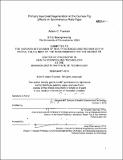Primary neuronal degeneration in the guinea pig effects on spontaneous rate-type
Author(s)
Furman, Adam C. (Adam Charles)
DownloadFull printable version (17.37Mb)
Other Contributors
Harvard--MIT Program in Health Sciences and Technology.
Advisor
M. Charles Liberman.
Terms of use
Metadata
Show full item recordAbstract
Acoustic overexposure can cause death of cochlear nerve fibers, even if elevations in cochlear sensitivity are reversible and even if there is no hair cell loss. We hypothesized that this primary neural degeneration does not raise cochlear thresholds because it is selective for cochlear neurons with high thresholds and low spontaneous rates (SRs). We tested this hypothesis by recording from single cochlear neurons in guinea pigs and evaluating neuronal degeneration via confocal microscopy 14 days after exposure to noise (4-8kHz, 106dB SPL, 2 hrs). Suprathreshold amplitudes of otoacoustic emissions recovered post-exposure, suggesting complete hair cell recovery; suprathreshold amplitudes of the auditory brainstem response remained attenuated for high-frequency stimuli, consistent with primary neural degeneration in the basal half of the cochlea. Single-fiber recordings from exposed animals showed that all sound-evoked response properties, including threshold, sharpness of tuning, maximum discharge rate, dynamic range, response adaptation, and recovery from forward masking, were indistinguishable from responses recorded from unexposed controls. The only physiological abnormalities were revealed in the population statistics: in high-frequency regions where low- SR (<20sp/sec) fibers are 47% of the control ear, that number was reduced to 29% in the exposed ear. Cochlear afferent synapses were counted after immunostaining for juxtaposed pre-synaptic ribbons and post-synaptic glutamate receptor patches in the inner hair cell area. The observed 20% synapse loss throughout the basal half of the cochlea was consistent with the physiological data. Analysis of synaptic morphology suggested remaining pre-synaptic ribbons were hypertrophied and membrane localization of post-synaptic glutamate receptors was reduced. The significance of the ribbon hypertrophy is unclear, but reduced receptor expression may represent receptor internalization, suggested as a mechanism to minimize the glutamate excitotoxicity that underlies this noise-induced degeneration. In the normal ear, fibers with high thresholds and low SRs are relatively insensitive to masking, thus are important for hearing in a noisy environment. We speculate that over a lifetime of repeated moderate noise exposure, the typical human ear may selectively lose these low-SR fibers and that this selective neuropathy may be an important contributor to the well-known problems with hearing-in-noise in the aging ear.
Description
Thesis (Ph. D.)--Harvard-MIT Program in Health Sciences and Technology. Cataloged from PDF version of thesis. Includes bibliographical references (p. 63-66).
Date issued
2013Department
Harvard University--MIT Division of Health Sciences and TechnologyPublisher
Massachusetts Institute of Technology
Keywords
Harvard--MIT Program in Health Sciences and Technology.